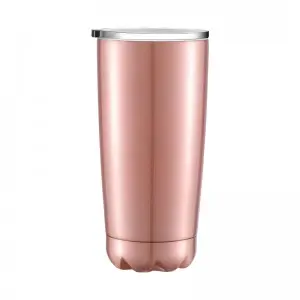Travel mugs have become a must-have accessory for those who are always on the go or have their favorite beverage with them. These versatile and functional containers keep our beverages hot or cold, prevent spills and reduce our carbon footprint through their sustainable design. But have you ever wondered how these impressive travel mugs are made? Join us on a fascinating journey to uncover the secrets behind the making of our travel mugs!
1. Select material:
Manufacturers carefully select materials for travel mugs to ensure durability, insulation, and convenience. The most commonly used materials include stainless steel, BPA-free plastic, glass and ceramic. Each material has its own advantages, such as the heat retention of stainless steel or the aesthetics of ceramics. Manufacturers work hard to find the ideal combination of materials to keep travel mugs strong and stylish.
2. Design and modeling:
Once a material is chosen, designers create complex molds and prototypes to perfect the shape, size and function of the travel mug. Meticulous attention to detail is required at this stage, as the travel mug must be ergonomically designed for a comfortable grip, easy opening and closing, and hassle-free cleaning.
3. Form the body:
At this stage, the chosen material (perhaps stainless steel or BPA-free plastic) is artfully molded into the body of the travel mug. If stainless steel is used, the steel plate is heated and molded into the desired shape using a high-pressure hydraulic press or by spinning the material on a lathe. On the other hand, if you choose plastic, you do injection molding. The plastic is melted, injected into the mold and cooled to form the main structure of the cup.
4. Core wire insulation:
To ensure your drinks stay hot or cold for longer, the travel mug is designed with insulation. These layers usually consist of vacuum insulation or foam insulation. In vacuum insulation, two stainless steel walls are welded together to create a vacuum layer that prevents heat from passing in or out. Foam insulation involves injecting a layer of insulating foam between two layers of steel to limit internal temperatures.
5. Add the cover and fittings:
A lid is an essential part of any travel mug as it prevents spills and makes sipping on the go a breeze. Travel mugs often come with leak- and spill-resistant lids designed with intricate seals and closures. Additionally, manufacturers include handles, grips, or silicone covers for enhanced comfort and grip options.
6. Finishing work:
Before the travel mugs leave the factory, they go through several finishing touches to prepare them for mass production. This includes removing any imperfections, such as burrs or sharp edges, and making sure the travel mug is completely airtight and leak-proof. Finally, decorative elements such as prints, logos or patterns can be added to give the travel mug a unique and personal touch.
The next time you take a sip from your trusty travel mug, take a moment to appreciate the craftsmanship and engineering of this practical everyday item. From selecting materials to the intricate manufacturing process, every step contributes to the final product that keeps our beverages at the perfect temperature and keeps us comfortable wherever we go. Learn about the carefully planned process behind the creation of your travel mug, adding a sense of appreciation as you accompany your adventures with your favorite drink in hand.
Post time: Aug-16-2023
